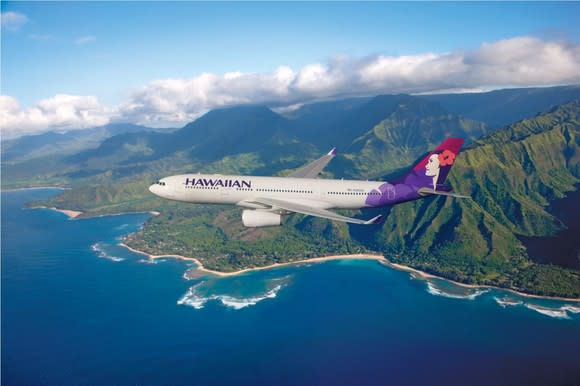Hawaiian Holdings Stock Could Soar Much Higher
After a lackluster performance in the first few months of 2018, shares of Hawaiian Holdings (NASDAQ: HA) surged higher following the company's stellar first-quarter earnings report. (The stock has since retreated due to worries about a volcanic eruption on Hawaii's Big Island and new reports about Southwest Airlines' plans to serve Hawaii.)
Hawaiian Airlines achieved a solid 4.9% increase in revenue per available seat mile (RASM) last quarter, despite United Continental's (NYSE: UAL) massive expansion in Hawaii, outpacing its 4.3% uptick in adjusted non-fuel unit costs. This allowed Hawaiian to post adjusted EPS of $1.09 -- up 11% year over year.
Hawaiian Airlines' RASM growth will slow in the second quarter -- driven in part by the timing of Easter -- while cost pressures will increase. As a result, pre-tax profit is likely to fall sharply. However, Hawaiian's outlook for the second half of 2018 and beyond is quite strong. With the stock trading for less than seven times earnings, there is clearly tons of upside for shareholders.
Revenue trends are very encouraging
Hawaiian Airlines' second-quarter guidance implies that RASM will rise about 3% for the first half of 2018. That would be impressive, given that United's rapid growth has caused industry capacity to increase by double digits on mainland-Hawaii routes. Hawaiian Airlines has also faced tough year-over-year revenue comparisons. (RASM surged 8.4% in the first half of 2017.)
By contrast, industry capacity growth on North America routes is set to decelerate to single-digit territory in the back half of the year. Hawaiian will also face easier comparisons going forward, as RASM rose less than 5% in the second half of 2017.

Hawaiian Airlines should be able to post strong RASM growth later this year. Image source: Hawaiian Airlines.
To be fair, Hawaiian Airlines is currently benefiting from a big decrease in competition within the Hawaii interisland market after its main competitor collapsed last November. Meanwhile, the return of fuel surcharges in some international markets (mainly Japan) has driven strong RASM growth. Thus, RASM momentum in those two parts of the business will likely slow in 2019. But by then, North America-Hawaii unit revenue trends should be improving.
Cost trends will turn around in the second half of 2018
An equally important part of the investment case for Hawaiian Holdings is its improving unit cost trajectory. Adjusted non-fuel unit costs surged 6.9% in 2017 and will rise by about 5% in the first half of 2018. Yet by the second half of this year, Hawaiian's management expects non-fuel unit costs to be approximately flat year over year.
The key to this unit cost improvement is the pending replacement of Hawaiian's Boeing 767 fleet with state-of-the-art Airbus A321neos. Right now, the carrier is suffering from elevated costs related to delays in its A321neo deliveries. For example, it had to extend the life of one 767 by performing extra maintenance work on it, and pilot productivity has suffered due to the carrier operating fewer A321neos than planned.
Fortunately, Hawaiian Airlines expects to receive all nine scheduled 2018 A321neo deliveries by year-end. This will allow it to retire the last of its 767s at the end of 2018 as planned.
The 2019 outlook is excellent
By the beginning of 2019, Hawaiian will have lapped United Continental's Hawaii growth, which should translate to lower competitive capacity increases. (While Southwest Airlines plans to fly to Hawaii beginning in late 2018 or early 2019, it has indicated that it will start small.)
Given that mainland-Hawaii unit revenue has held up extremely well this year despite United's big Hawaii expansion, slower capacity growth in 2019 will likely translate to solid RASM increases. Additionally, by replacing its eight 767s with A321neos, Hawaiian will be able to reduce capacity on lower-demand routes while increasing the proportion of premium seats on those flights. That should also contribute to unit revenue growth.
On the cost side, Hawaiian Airlines is now likely to get most of the benefit from its fleet renewal project in 2019. The new A321neos could be about 30% more fuel efficient than the 767s they replace, will have a lower cost of ownership, and they will be much cheaper to maintain.
Additionally, the cost headwinds from A321neo pilot training and from opening Hawaiian's new maintenance and cargo facility will abate next year. The carrier also signed a new contract with a maintenance vendor in late 2017, which will reduce costs starting next year.
The net result is that non-fuel unit costs will probably be flat or down in 2019 and fuel efficiency will improve significantly. This means that Hawaiian Airlines should be able to achieve margin expansion even with modest unit revenue growth. With analysts currently expecting EPS to decline next year, Hawaiian Airlines is in good position to continue performing well above expectations -- driving big gains for Hawaiian Holdings stock.
More From The Motley Fool
Adam Levine-Weinberg owns shares of Hawaiian Holdings. The Motley Fool has no position in any of the stocks mentioned. The Motley Fool has a disclosure policy.

 Yahoo Finance
Yahoo Finance 